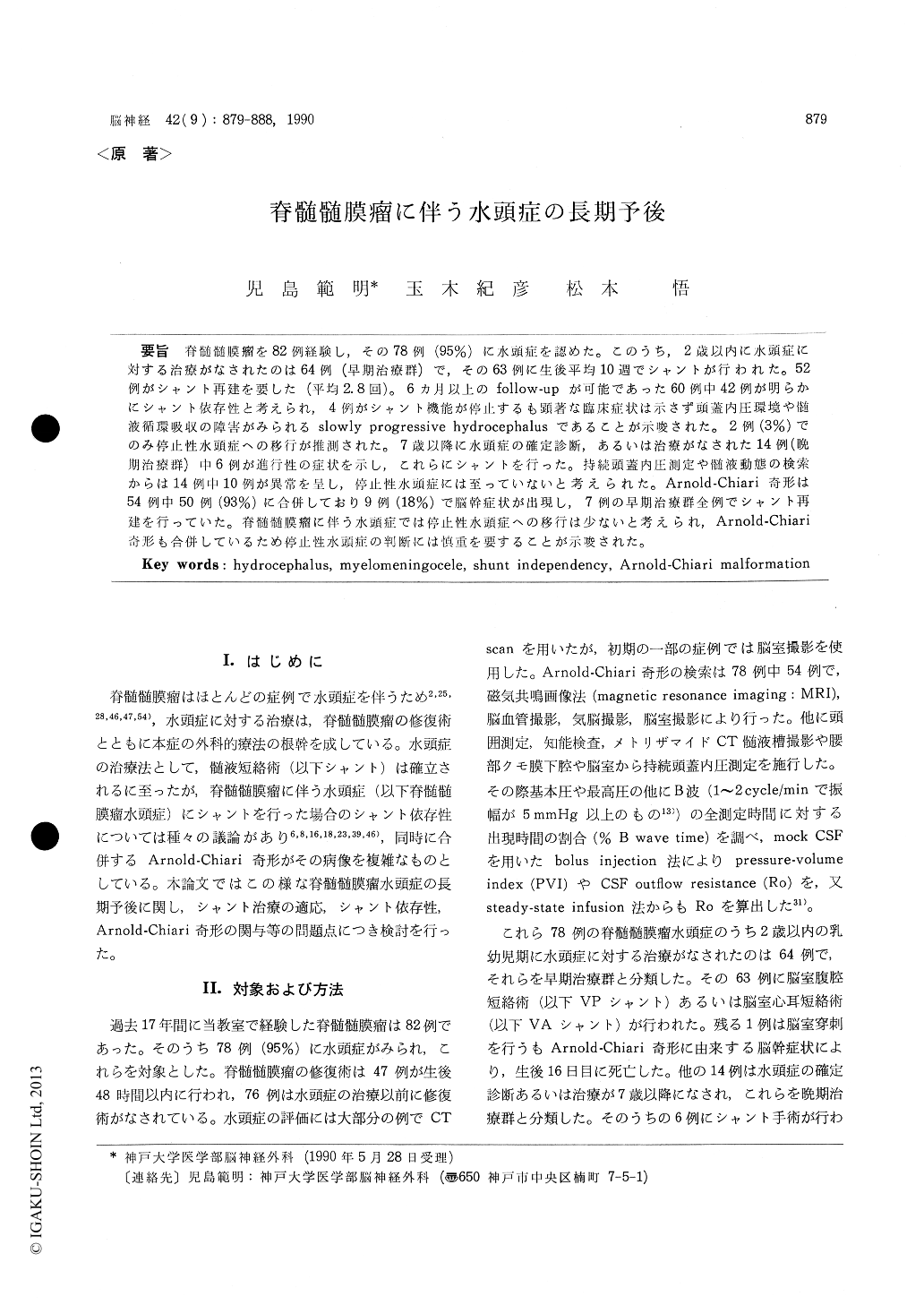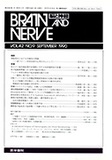Japanese
English
- 有料閲覧
- Abstract 文献概要
- 1ページ目 Look Inside
脊髄髄膜瘤を82例経験し,その78例(95%)に水頭症を認めた。このうち,2歳以内に水頭症に対する治療がなされたのは64例(早期治療群)で,その63例に生後平均10週でシャントが行われた。52例がシャント再建を要した(平均2.8回)。6カ月以上のfollow-upが可能であった60例中42例が明らかにシャント依存性と考えられ,4例がシャント機能が停止するも顕著な臨床症状は示さず頭蓋内圧環境や髄液循環吸収の障害がみられるslowly progressive hydrocephalusであることが示唆された。2例(3%)でのみ停止性水頭症への移行が推測された。7歳以降に水頭症の確定診断,あるいは治療がなされた14例(晩期治療群)中6例が進行性の症状を示し,これらにシャントを行った。持続頭蓋内圧測定や髄液動態の検索からは14例中10例が異常を呈し,停止性水頭症には至っていないと考えられた。Arnold—Chiari奇形は54例中50例(93%)に合併しており9例(18%)で脳幹症状が出現し,7例の早期治療群全例でシャント再建を行っていた。脊髄髄膜瘤に伴う水頭症では停止性水頭症への移行は少ないと考えられ,Arnold-Chiari奇形も合併しているため停止性水頭症の判断には慎重を要することが示唆された。
This paper reviews long-term follow-up studies of 78 hydrocephalic patients with myelomeningo-cele. Seventy-eight (95%) out of 82 patients with myelomeningocele had hydrocephalus. CT, MRI, CT cisternography, and monitoring of intracranial pressure (ICP) with infusion methods were per-formed to evaluate the indication of shunt inser-tion or shunt independency. These hydrocephalic patients consisted of the following two groups :
( 1 ) Early treated group. Sixty-four cases received initial cerebrospinal fluid (CSF) diversion operation within 2 years of life. Sixty-three pa-tients had a ventriculoperitoneal (VP) or a ven-tricu-loatrial (VA) shunt. All the patients of this group showed progressive signs and symptoms of increased ICP due to hydrocephalus. The mean age at the initial shunt placement was 10 weeks. The mean value of Evans' index before shunting was 47%, which corresponded to moderate ven-triculomegaly. 48% of this group showed slit-like ventricles on postoperative CT scans, where 52% had normal or only mildly dilated ventricles subse-quent to shunting. There were two instances (3%) of the so-called "slit ventricle syndrome" and one instance of "isolated fourth ventricle", who had un-dergone multiple shunt revisions. Shunt revisions were performed on fifty-two occasions in this group. The mean number of shunt revisions perchild was 2. 8. Sixty among 64 patients of this group were suitable for evaluating shunt depend-ency with long-term follow-up period. Forty-two out of 60 patients were considered to be shunt dependent, who underwent multiple shunt revisions after 6 months of age. These patients had signs and symptoms of increased ICP, neurological dete-rioration, and enlarged ventricles when their shunts were blocked. There were four cases of slowly progressive (shunt dependent) hydroce-phalus, who did not show clinical signs and symp-toms of shunts malfunction in spite of progressive ventriculomegaly and abnormal findings of CT cisternography and ICP monitoring. Only two patients (3%) proved to be shunt independent. Consistently their ventricles were mildly dilated. These results suggest a very low incidence of true arrest of hydrocephalus after shunt operation. ( 2 ) Late treated group. Fourteen cases were diagnosed or treated for hydrocephalus after 7 years of age. Six out of fourteen patients had re-markable hydrocephalus whose Evans' index ex-ceeded 51%. The mean value of Evans' index was 48% in this group. Six patients had progressive signs and symptoms of hydrocephalus and were shunted. ICP monitoriong and studies of CSF dy-namics revealed abnormal findings in ten out of 14 cases in spite of preservation of good intelligence. "Spontaneous arrest" of hydrocephalus might be quite rare in patients with myelomeningocele un-less these infants are shunted.
Fifty out of 54 patients (93%) were associated with Arnold-Chiari malformation and nine had sig-nificant sequelae of hindbrain dysfunction. Five had posterior fossa decompression. One died be-cause of pneumonia ; three recovered and one re-mained unchanged. These results might indicate that shunt independence or arrested hydrocephalus would be rare in patients with myelomeningocele in association with the high risks of decompen-sation due to hindbrain anomaly.

Copyright © 1990, Igaku-Shoin Ltd. All rights reserved.


